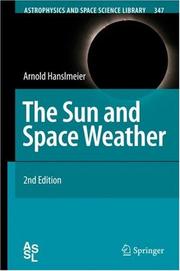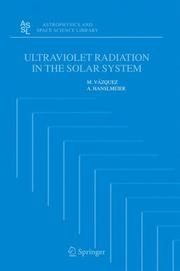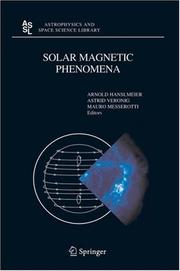| Listing 1 - 5 of 5 |
Sort by
|

ISBN: 1280949082 9786610949083 1402056044 1402056036 Year: 2007 Publisher: Dordrecht : Springer,
Abstract | Keywords | Export | Availability | Bookmark
 Loading...
Loading...Choose an application
- Reference Manager
- EndNote
- RefWorks (Direct export to RefWorks)
This second edition is a great enhancement of literature which will help the reader get deeper into the specific topics. There are new sections included such as space weather data sources and examples, new satellite missions, and the latest results. At the end a comprehensive index is given which will allow the reader to quickly find his topics of interest. The Sun and Space weather are two rapidly evolving topics. The importance of the Sun for the Earth, life on Earth, climate and weather processes was recognized long ago by the ancients. Now, for the first time there is a continuous surveillance of solar activity at nearly all wavelengths. These data can be used to improve our understanding of the complex Sun-Earth interaction. The first chapters of the book deal with the Sun as a star and its activity phenomena as well as its activity cycle in order to understand the complex physics of the Sun-Earth system. The reader will see that there are many phenomena but still no definite explanations and models exist for many of them. Other topics are the influences on the Earth’s atmosphere, long and short term climate variations. The last chapters discuss the protection against enhanced radiation environment in view of upcoming manned missions to the Moon and Mars, and the threat from space debris, asteroids and meteoroids. Since the field is quite interdisciplinary, the book will be of interest to scientists working in different fields such as solar physics, geophysics, and space physics.
Space environment. --- Meteorology. --- Solar radiation. --- Sun. --- Absorption, Atmospheric --- Atmospheric absorption of solar radiation --- Insolation --- Radiation, Solar --- Electromagnetic waves --- Aerology --- Earth sciences --- Atmosphere --- Environment, Space --- Extraterrestrial environment --- Space weather --- Extreme environments --- Solar system --- Atmospheric science
Book
ISBN: 3540769447 9786611876265 1281876267 3540769455 Year: 2009 Publisher: Berlin, Heidelberg : Springer Berlin Heidelberg : Imprint: Springer,
Abstract | Keywords | Export | Availability | Bookmark
 Loading...
Loading...Choose an application
- Reference Manager
- EndNote
- RefWorks (Direct export to RefWorks)
The solar system has a rather well-known history. Looking at the present situation, one might get the impression that it was a rather stable and well-defined system: the orbits of the planets appear to be stable, climate and atmospheres on the planets have been determined, the risk of collision with other bodies (comets, asteroids, meteorites) seems to be small. However it is known today that the evolution of life on Earth was neither a steady progression nor uniform. There were several periods of mass extinction. These catastrophic events played a crucial role in the rise of new species. Events of astrophysical origin include: • Asteroid impacts • Major solar variabilty (space weather) • Nearby supernovae • The passage of the solar system through dense interstellar clouds Catastrophic cosmic events of this type appear in the range of some 100 million years. The author discusses whether and how such events could have occurred in the solar system as well as in recently found extrasolar planetary systems. In this text, which addresses readers in the field of Astrophysics and Astrobiology but also Geophysics and Biology these cosmic catastrophic events are described at an intermediate student's level.
Astrophysics. --- Life on other planets. --- Natural disasters. --- Habitable planets --- Exobiology --- Natural disasters --- Catastrophes (Geology) --- Astrophysics --- Life on other planets --- Astronomy & Astrophysics --- Biology --- Physical Sciences & Mathematics --- Health & Biological Sciences --- Biology - General --- Habitable planets. --- Exobiology. --- Extraterrestrial life --- Astronomical physics --- Natural calamities --- Astrobiology --- Earth-like planets --- Earthlike planets --- Physics. --- Planetology. --- Space sciences. --- Astrobiology. --- Climate change. --- Radiation protection. --- Radiation --- Astrophysics and Astroparticles. --- Extraterrestrial Physics, Space Sciences. --- Climate Change. --- Effects of Radiation/Radiation Protection. --- Safety measures. --- Astronomy --- Cosmic physics --- Physics --- Planets --- Fermi's paradox --- Historical geology --- Disasters --- Life --- Extrasolar planets --- Origin --- Climatic changes. --- Environmental protection. --- Space Sciences (including Extraterrestrial Physics, Space Exploration and Astronautics). --- Changes, Climatic --- Changes in climate --- Climate change --- Climate change science --- Climate changes --- Climate variations --- Climatic change --- Climatic changes --- Climatic fluctuations --- Climatic variations --- Global climate changes --- Global climatic changes --- Climatology --- Climate change mitigation --- Teleconnections (Climatology) --- Planetary sciences --- Planetology --- Environmental quality management --- Protection of environment --- Environmental sciences --- Applied ecology --- Environmental engineering --- Environmental policy --- Environmental quality --- Environmental aspects --- Radiation—Safety measures. --- Radiation monitoring --- Radiation protection --- Science and space --- Space research --- Cosmology --- Science --- Global environmental change --- Planetary science.
Book
ISBN: 160805473X 9781608054732 9781608055999 Year: 2013 Publisher: [Sharjah, U.A.E.] : Bentham Science Publishers,
Abstract | Keywords | Export | Availability | Bookmark
 Loading...
Loading...Choose an application
- Reference Manager
- EndNote
- RefWorks (Direct export to RefWorks)
Astrobiology refers to the study of the origin, evolution, distribution, and future of life in the universe. This encompasses extraterrestrial life and life on Earth. Astrobiology is an interdisciplinary field that is gaining a rapidly growing interest among both the general public and the astronomical research community. This e-book explains the detection and evolution of exoplanets and discusses the question of habitability on such objects. Chapters in this text include cited references enabling the reader to acquire more information on specific aspects of astrobiology. It is also a suitable
Exobiology. --- Life on other planets. --- Astrobiology --- Biology --- Habitable planets --- Life --- Extraterrestrial life --- Planets --- Fermi's paradox --- Origin

ISBN: 1280624442 9786610624447 1402037309 1402037260 9048169437 Year: 2006 Publisher: Dordrecht ; [Great Britain] : Springer,
Abstract | Keywords | Export | Availability | Bookmark
 Loading...
Loading...Choose an application
- Reference Manager
- EndNote
- RefWorks (Direct export to RefWorks)
UV radiation is an important part in the electromagnetic spectrum since the energy of the photons is great enough to produce important chemical reactions in the atmospheres of planets and satellites of our Solar System, thereby affecting the transmission of this radiation to the ground and its physical properties. Scientists have used different techniques (balloons and rockets) to access to the information contained in this radiation, but the pioneering of this new frontier has not been free of dangers. The Sun is our main source of UV radiation and its description occupies the first two chapters of the book. The Earth is the only known location where life exists in a planetary system and therefore where the interaction of living organism with UV radiation can be tested through different epochs and on distinct species. The development of the human technology has affected the natural shield of ozone that protects complex lifeforms against damaging UV irradiation. The formation of the ozone hole and its consequences are described, together with the possible contribution of UV radiation to recent climate changes. Finally, we will discuss the potential role of ultraviolet light in the development of life on bodies such as Mars, Europa and Titan. The Solar System is not isolated; other external sources can contribute to the enhancement of the UV radiation in our environment. The influence of such events as nearby supernovae and gamma-ray bursts are described, together with the consequences to terrestrial life from such events.
Ultraviolet radiation. --- Solar radiation. --- Astrophysics. --- Solar system. --- Milky Way --- Astronomical physics --- Astronomy --- Cosmic physics --- Physics --- Absorption, Atmospheric --- Atmospheric absorption of solar radiation --- Insolation --- Radiation, Solar --- Electromagnetic waves --- Black light --- Light, Black --- Light, Ultraviolet --- Rays, Ultraviolet --- U-V light --- U-V radiation --- U-V rays --- Ultra-violet radiation --- Ultra-violet rays --- Ultraviolet light --- Ultraviolet rays --- UV light --- UV radiation --- UV rays --- Radiation --- Astrobiology. --- Oncology. --- Climatic changes. --- Environmental protection. --- Astrophysics and Astroparticles. --- Astronomy, Observations and Techniques. --- Cancer Research. --- Climate Change. --- Effects of Radiation/Radiation Protection. --- Environmental quality management --- Protection of environment --- Environmental sciences --- Applied ecology --- Environmental engineering --- Environmental policy --- Environmental quality --- Changes, Climatic --- Changes in climate --- Climate change --- Climate change science --- Climate changes --- Climate variations --- Climatic change --- Climatic changes --- Climatic fluctuations --- Climatic variations --- Global climate changes --- Global climatic changes --- Climatology --- Climate change mitigation --- Teleconnections (Climatology) --- Tumors --- Astrobiology --- Biology --- Habitable planets --- Life --- Environmental aspects --- Origin --- Observations, Astronomical. --- Astronomy—Observations. --- Cancer research. --- Climate change. --- Radiation protection. --- Radiation—Safety measures. --- Radiation monitoring --- Radiation protection --- Cancer research --- Astronomical observations --- Observations, Astronomical --- Global environmental change

ISBN: 1280263652 9786610263653 1402029624 1402029616 9400793324 Year: 2005 Publisher: Dordrecht ; Norwell, MA : Springer,
Abstract | Keywords | Export | Availability | Bookmark
 Loading...
Loading...Choose an application
- Reference Manager
- EndNote
- RefWorks (Direct export to RefWorks)
The book contains lecture papers and contributed papers on different aspects of magnetic phenomena in the solar atmosphere. The main topics addressed are the physics of solar flares, prominences, coronal mass ejections, magnetic helicity, high-energy radiation from the Sun, observations of the photosphere and chromosphere as well as highlights from the SOHO mission. The lecture papers provide a very valuable introduction and overview on recent developments in these fields of solar physics. The comprehensive lists of references at the end of each review enable the interested reader to go into m
Solar magnetic fields --- Solar radiation --- Astronomy. --- Astrophysics. --- Astronomy, Astrophysics and Cosmology. --- Space Sciences (including Extraterrestrial Physics, Space Exploration and Astronautics). --- Astronomical physics --- Astronomy --- Cosmic physics --- Physics --- Space sciences. --- Science and space --- Space research --- Cosmology --- Science
| Listing 1 - 5 of 5 |
Sort by
|

 Search
Search Feedback
Feedback About UniCat
About UniCat  Help
Help News
News